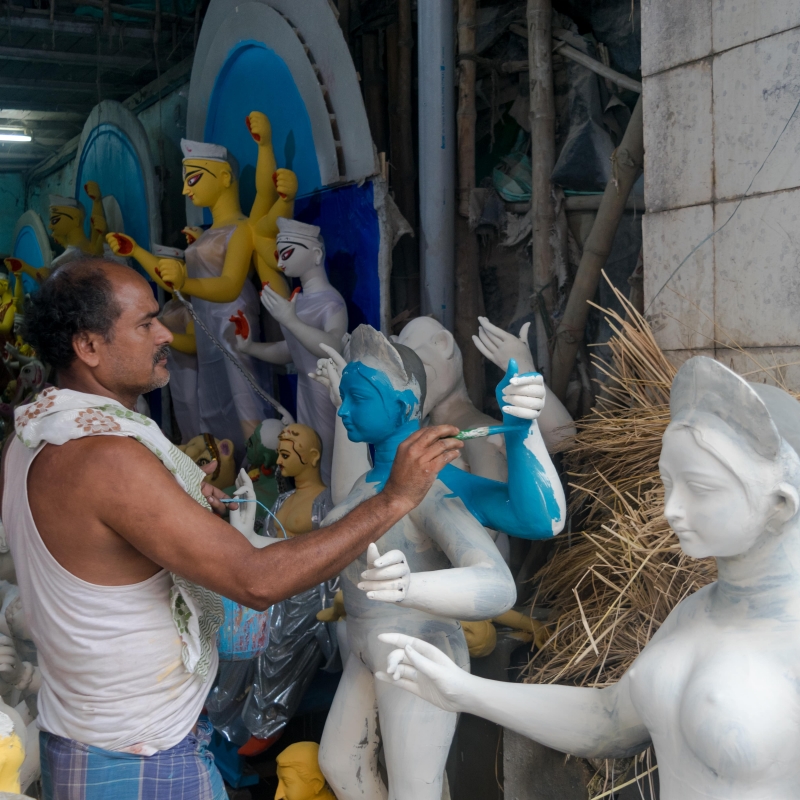Every autumn, Kolkata gets ready to welcome Goddess Durga. It is that time of year when the city celebrates the spirit of love, laughter and life. Thousands of people throng the streets both from within as well as outside Kolkata to visit different pandals and view idols of Durga. However, Durga Puja is not just about celebrating the goddess but also the different forms of art, craft and traditions associated with it. One such community without whom the Durga Puja celebrations are incomplete are the potters of Kumortuli; these potters work day and night to create the clay idols to be worshipped during the Durga Puja.
Kumortuli is a traditional potters’ colony in northern Kolkata (kumor meaning potter and tuli refers to easily walkable localities within a quarter or half a mile). The potters treat these colonies as their place of living as well as workspace. But how did this neighbourhood come to exist? To find the answer, one has to go back some 300 years to Krishnanagar, a small city in Nadia district of West Bengal, renowned for its clay-modelling industry. The clay modellers of Krishnanagar are said to be descendants of immigrants from Dhaka, Bangladesh. During Maharaja Krishnachandra’s rule in Nadia, the practice of idol worship grew, which in turn called for potters and craftsmen from Dhaka. These clay modellers came to Krishnanagar and started living around a place called Ghurni. Ghurni is near the river Jalangi (also called Khoray), so potters could easily procure clay they needed. In due course, Ghurni grew up to be the potters’ colony.
The first recorded Durga Puja seems to have been celebrated in Krishnanagar by its royal family and dates back to 1606. Around 1757, Raja Nabakrishna Deb of Shobhabazar Rajbari (king’s palace) in north Kolkata, inspired by Raja Krishnachandra, started the tradition of Durga Pujo at his family home. Skilled kumors were brought from Krishnanagar to create idols of the goddess—this was the genesis of Kumortuli. Workers slowly started settling in Kumortuli by the Hoogly riverside.
Initially, Durga Puja in Bengal was celebrated only by the zamindars, so the work of the craftsmen was mostly seasonal and they would make other clay items to sustain themselves. Even today, Kumortuli’s potters make crockery from clay. Some kumors who are not engaged in idol making make crockery full-time.
Durga Puja rose to prominence during the British rule when Hindu reformists identified the mother goddess with the nation. The number of Durga Puja celebrations increased from the early twentieth century onward. Around this time, Puja was also celebrated at a community level and reflected through the baroyari (12 friends) tradition, which derives its name form puja performed by 12 people of Guptipara in Hooghly district. In later years, the term sarbojanin (community) replaced the word baroyari.
The first community puja in Kolkata dates back to the sarbojanin puja at Balaram Basu Ghat Road in 1910. With time, the number of Durga Pujas grew steadily and the number of kumors in Kumortuli grew to keep pace with the demand for clay idols. Many migrant workers from Krishnanagar and other parts of Nadia moved to Kumortuli to live permanently there. Today, idols made here are also imported by Bengali communities in countries such as France, England, USA and Germany.
Kumortuli is situated in Ward No. 9 of Kolkata Municipal Corporation, between Ahiritola and Shhobhabazar, and bound by Rabindra Sarani (formerly Chitpur Road) and the river Hoogly. The narrow alleys with craftsmen’s working studios, the smell of wet mud and the collections of idols left to dry along the lanes give the colony a distinct visual character and identity.
Process of Idol Making
The Craftsmen
The process of idol making is tedious, demanding a multitude of skilled and unskilled activities (Fig. 1). Workers are assigned specific jobs. For example, some workers only draw the eyes on the face of the deity, in a process called chokkhudaan (offering eyes). Others create hands from moulds or are assigned the task of colouring the idols. While some craftsmen only assist the main worker.
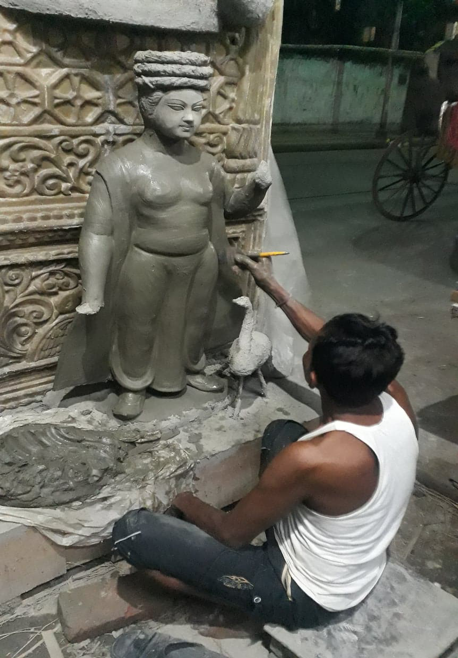
The wages of the labourers can range from Rs 500 to Rs 10,000 depending on the work and the working hours of the labourer. Since the work is mostly seasonal, wages also depend to an extent on the work schedule. The active period for workers is July to January or February, and the busiest is August to October, the main festive season of Kolkata. During peak months, labourers engage in extra hours of work and their wages are increased slightly (Fig. 2). The increase in wage ranges from Rs 50 to Rs 200 per day, depending on the work. These studios also provide informal lessons to budding artists and sculptors. College students who wish to learn this art form visit the studios and watch the skilled workers sculpt.
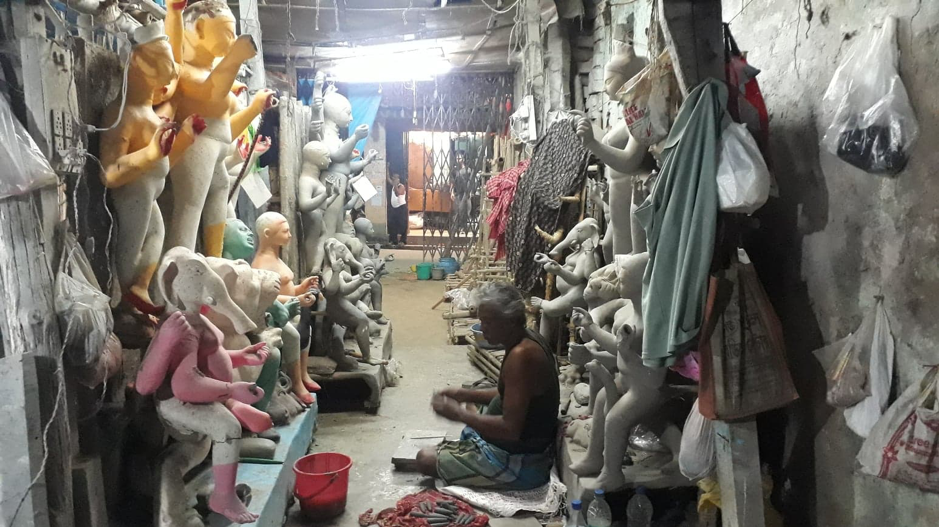
Traditionally, only men engaged in the craft of idol making. Many craftsmen still believe that women should stay at home and only indirectly assist their male counterparts by cooking for them during their work hours. This thinking is also guided by the belief that meyere maayer jaat (women are akin to goddesses) and should not engage in any form of business that requires them to step out and toil to earn money. However, the situation is changing and, today, many women are carrying forward their father’s or husband’s business.
In the 1990s, women craftsmen such as Mala Pal and China Pal entered the business. Mala Pal was around 15 years old when she got into idol making, because of the financial hardships following her father’s death. She initially assisted her brother Gobinda Pal but gained recognition after she was called to exhibit at the National Handicrafts and Handloom Museum, New Delhi. Mala recollects this event as a turning point in her life. Though at first her family was reluctant about her choice, they eventually embraced it. Today, she works with a team of seven to eight people and specialises in miniature Durga idols that are shipped to destinations such as Germany, France, Canada and USA.
China Pal’s journey is similar. She has been in the profession for more than two decades, starting in 1994 after her father’s demise just before the pujas that year. She had no formal training in the art, so there were hiccups in the beginning. But, as China says, she always had a knack for it.[1]
She started working with her father’s team and learnt sculpting. Her father specialised in ek chala (idols with a single background) idols and she carries forward the legacy. China Pal now has her own group of artisans, and also trains new idol makers. Her idols are shipped abroad and she is invited to exhibit her work as well.
Types of Idols
Several types of Durga idols are created in Kumortuli, but the two main categories are ek chala and do chala (with more than one background) which developed much later and out of necessity. According to local legend, in the year 1937 or 1938 a huge fire in the puja organised by Kumortuli Sarbojanin Puja Committee destroyed the Durga idols. To help the committee members, a kumor named Gopeshwar Pal created new idols overnight, breaking away from the traditional style of ek chala and adopting the new do chala design.
Apart from the backgrounds, there are other distinct differences among the idols. The ‘Art Bangla Durga’, a combination of features from traditional and modern Durga idols, is five to 14 feet tall and decorated with zari or solapith (thermocol). Modern Durga idols are the least expensive. There are also the ‘Dobasi Bangla’ type (decorated with zari or sola), the ‘Khas Bangla’ type (five to eight feet tall and decorated entirely with sola) and ‘Ajanta Ellora Durga’ (made entirely of clay).
The Stages of Idol Making
The idol making process can be categorised broadly into three stages. The first stage is making the kathamo (bamboo and wooden frame) for the idol, the second is preparing the mud and applying the clay, and the third is colouring and decorating the idol.
The first stage, making the kathamo, involves buying wood and bamboo from the market, cutting and joining them with pins or tying them together with ropes to build the skeleton structure (Fig. 3). Before the sculpting begins, the kathamo is worshipped and a few rituals are performed by those who take the idols back to their pandals. Once the kathamo is complete, it is tied with straw to give it a rough shape of the idol.
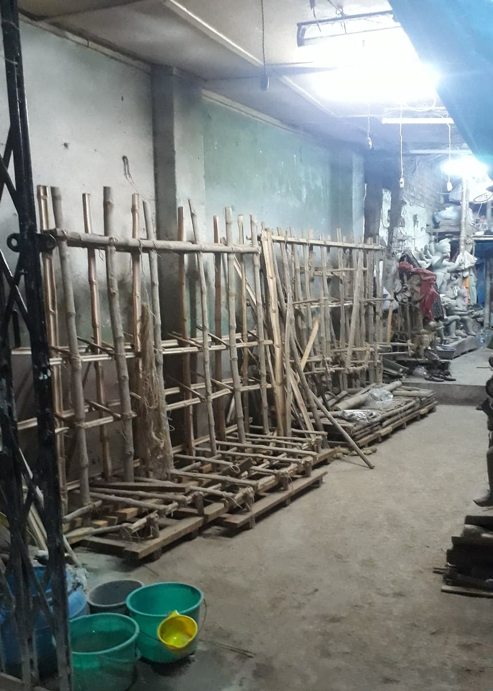
In the subsequent process, the kumors apply mud to the straw framework of the idol. The mud used is a mixture of clay (brought from the riverside in Uluberia village because the sand content is lower than in the banks of Hooghly) and water. The craftsmen stomp on the mud with their feet to remove impurities. (Fig. 4)
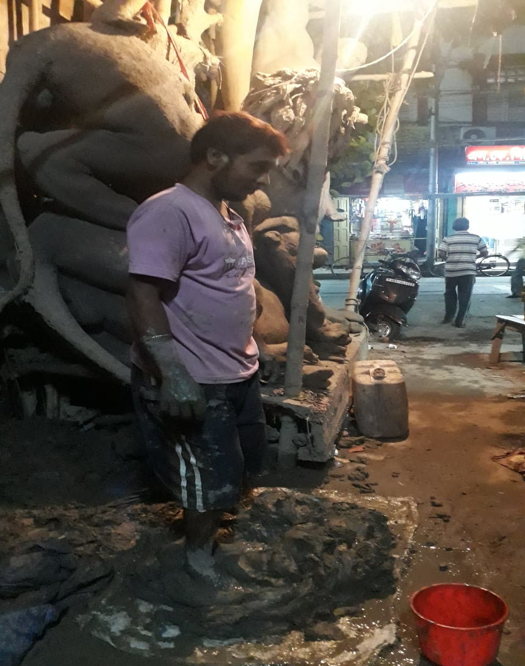
Two types of mud, with differing uses, go into sculpting the idols—entel mati (sticky clay) and bele mati (crisp clay). Entel mati is mixed with tush (husk of rice), which is applied on the straw framework of the idol and left to dry for three to four days. The bele mati is then applied on the layer of entel mati and left to dry for five to six days. If visible cracks are found on the dried idol structures, they are repaired with mud. (Fig. 5)
When the body of the idol is ready, the face, palms and fingers, which are separately made, are put together. (Fig. 6) Owing to the huge demand for idols, these parts are made from moulds as they reduce the time spent in making shapes over and over again. The face is made with bele mati and rubbed with paper to give it a polished finish. The idols are then coloured and decorated.
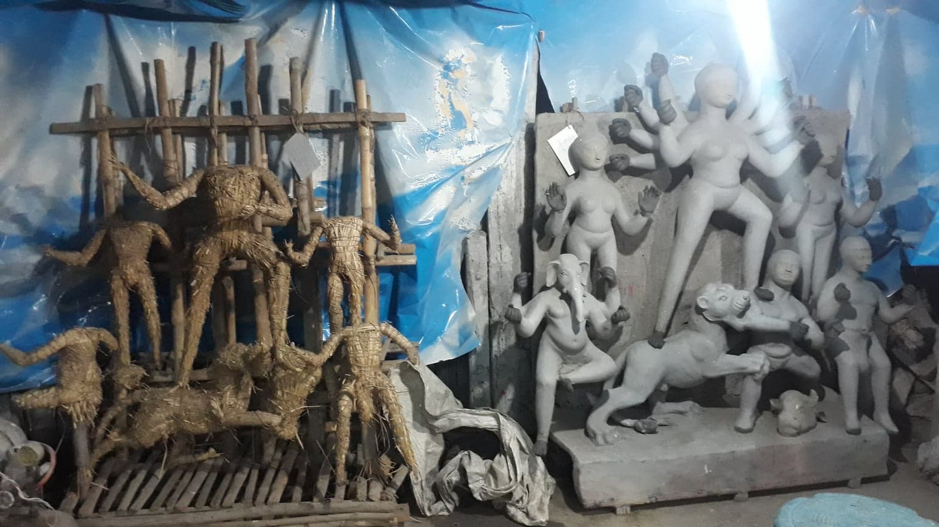
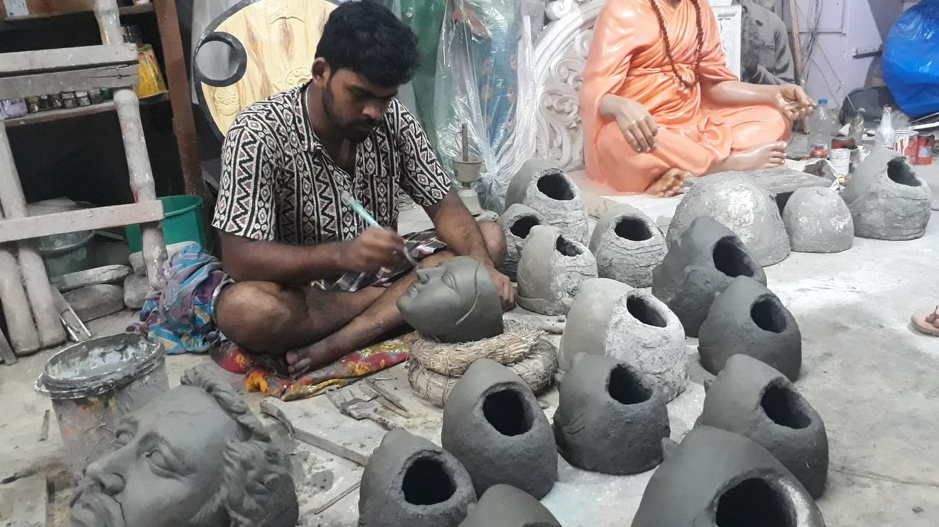
Problems
Kumortuli has, over centuries, absorbed changes in the art of idol making and in the lives of the people associated with it. Kolkata’s 300-year-old neighbourhood has experienced political, social and cultural changes that have significantly impacted its urbanscape. Despite being one the most significant creative clusters in the city, it faces various obstacles that stand in the way of its expansion and growth—a major challenge being housing.
The workshops are arranged linearly along the lanes, adjacent to each other. The workspaces, commonly known as studios, are jammed together. The residences are behind the work area, which means that the workspaces open on to the lane. The workspace and the residential spaces of the craftsmen are physically interlinked so that they cannot be separated from each other; their usage is also very much interconnected.
During the festive season when work goes on day and night, many craftsmen from nearby areas migrate to Kumortuli for work, and the nature of their work demands temporary residency. Kumortuli has two types of housing patterns—one is one-storeyed, with the workspace and inner residential quarter separated by a courtyard, and the other type is a two-storeyed building, where the basement is used as a workspace.
Sometimes several potter families share houses and workspaces, at times with common washrooms. The residential rooms are also used as storage spaces to keep the idols or products used in idol-making process.
Most of the craftsmen live in rented houses, with the threat of eviction a constant at any given time. Since they are temporary residents they cannot make changes to existing structures, even though most of the workspaces in Kumortuli are in a state of disrepair. Some studios also have erratic electricity supply; the craftsmen work in low light and as idol making requires minute detailing and precision, it takes a toll on their eyesight.
The troubles of the kumors increase especially during the festivals, when they struggle to keep the idols they make at one place, given the size of their quarters. Paucity of space also goes against their need to work together and they often have no choice but to spill on to the streets. (Fig. 7) The problem is compounded when it rains—the idols then have to be dried out. Because of the space crunch in the workspaces, many of the idols inside are kept outside and covered with tarpaulin. When they get damaged, the craftsmen incur huge losses.
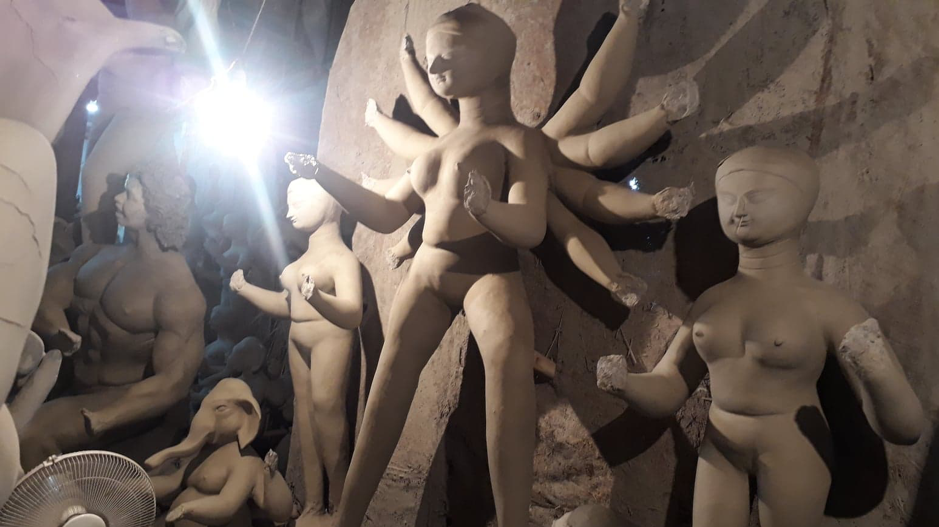
The number of puja pandals that celebrate Durga Puja are increasing every year. Kumortuli has absorbed many workers migrating from adjoining districts and has contributed to the growth of the informal sector. With the growth in celebrations of Durga Puja, the demand for idols is expected to increase, but problems of housing and workspace do not allow for this.
To give a boost for this informal sector, the state government, in 2007, took up a rehabilitation project. It aimed to provide better infrastructural facilities to the workers by improving housing and workspace conditions. This project, worth Rs 22 crore, was initiated under the Jawaharlal Nehru National Urban Renewal Mission (JNNURM), and the Kolkata Metropolitan Development Authority (KMDA) had the sole responsibility of implementing it.
The plan was to build houses for artisans, with the ground floor as working space and the upper storey as residential space. The houses were to have proper concrete walls, with a solid roof and proper sanitation facilities. For this purpose, the existing workspaces were to be demolished and the kumors temporarily relocated. According to the plan, some studios were brought down and the workers shifted to Golabari, a building belonging to the Food Corporation of India.
The new workshops were indeed better but right after the first phase of implementation, the project came to a halt for political reasons. In addition, many craftsmen were reluctant to move base because they feared losing out on the spatial benefits that their peers in the old place would still enjoy. The craftsmen also feared being alienated from the other workers as well as losing customers. Yet, they could also see the long-term benefits of such a programme’s successful implementation, because they understood that the future of idol making as an art perhaps depends on steps taken now. Otherwise, with the seasonal nature of their art and the deplorable conditions of living and working, the day is not far when idol making would become a dead art. After all, it is an art that is handed down generations and usually learnt in the family; in a world of fast-changing technologies and low profits for traditional idol making, how would the kumors convince their younger apprentices to follow the art?
For now, idol making is running on the undying spirits that kumors have for their art. As kumor Bankim Pal tells me expressively: while the best delicacies can treat his taste buds, the art of creation, the perfection that is carved, fills up his soul and gives him utmost happiness.[2]
He narrates stories of sleepless nights when he spent hours just getting the shape of an idol’s nose or the lips right.
Notes
[1] China Pal, in conversation with the author.
[2] Bankim Pal, in conversation with the author.
Bibliography
Chattopadhyay, Swati. Representing Calcutta: Modernity, Nationalism and Colonial Uncanny. New York and London: Routledge, 2005.
Chakrabarti, Shomak, et al. 'The ‘God Makers’ of Kolkata: Can improved infrastructure mitigate the misery of artisans in Kumartuli?' Cdedse.org. 2014. Accessed October 9, 2019. http://cdedse.org/wp-content/uploads/2018/06/4-2.pdf
Heierstad, G. Caste, Entrepreneurship and the Illusions of Tradition: Branding the Potters of Kolkata. London: Anthem Press, 2017.
McDermott, R.F. Revelry, Rivalry, and Longing for the Goddesses of Bengal: The Fortunes of Hindu Festivals.New York: Columbia University Press, 2011.
Mukherjee, Sreecheta, and Tarun Tapas Mukherjee, eds. Chitrolekha International Magazine on Art and Design. Kolkata: Sreecheta Mukherjee, 2013.
Nandan, R. Unleashing Your Entrepreneurial Potential. New Delhi: SAGE Publications, 2009.
Paul, Priyanka, Abhijit Das, and Jaydeep Mandal. ‘Technology of Idol Making: An Ethnographic Study in Kumartuli, Kolkata, West Bengal.’ The Research Journal of Social Sciences 9, no. 1 (2018): 103–13.
Raha, B., and S. Chattopadhyay. Mapping the Path to Maturity: A Connected History of Bengal and the North-East. New York and London: Routledge, 2018.
Saha, Deepanjan, and Joy Sen. ‘Understanding Clustering in Creative-Knowledge Cities: Creative Clusters in Kolkata, India.’ Journal of Engineering Technology (JET) 3, no. 4 (2016): 33–38.
